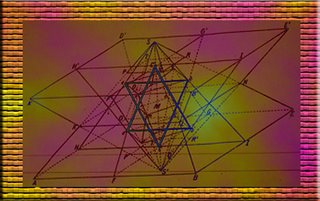 The following paragraph is from Dr. Asher Eder’s book The Star of David, which was published in 1987 in English in Jerusalem by Rubin Mass Ltd. The publication here is courtesy of Oren Mass
The following paragraph is from Dr. Asher Eder’s book The Star of David, which was published in 1987 in English in Jerusalem by Rubin Mass Ltd. The publication here is courtesy of Oren MassThis version includes corrections and new materials that do not appear on the printed version
In his most interesting studies about the Cosmic Numbers of the Cheops Pyramid, Dr.Noetling records an observation which led him to the conclusion that the architects of the Cheops pyramid knew the hexagram. He demonstrates that the measurements of the Cheops pyramid, and especially those of the stone coffer in its royal chamber, reflect perfectly all kinds of cosmic numbers.
In his searches, he found in Egypt, and curiously enough also in Burma, pedestals for statues in the shape of interlaced and decapped pyramids:
He found out that the drawing of the intersecting lines of these pedestals produces, naturally so, hexagrams whose angles differ in accordance with the geometrical intersection:
Since the base angles of the pyramid are not equal to the apex angle, the hexagrams
resulting from geometrical intersections cannot be equilateral either: we get "prolonged" or "squeezed" shapes. Dr. Noetling reasoned that these are the original shapes of the hexagram, and thus are the genuine ones which would reflect the cosmic numbers and qualities expressed by the pyramid. The harmonious hexagram, he suggests, is fashioned for the sake of ornamentation and beauty.
Interestingly enough, Dr. Ed Metzler in his profound studies on Mosaical Matrixes, comes to a similar result, however from a different point of view. He figured out that the original Two Tablets of the Decalogue consisted of two rectangular stone slabs which had the Ten Words written in ten lines in such a way that the slabs, besides showing the text of the Decalogue, set the standards for weights and measures of the Torah. The division of each tablet into 150 letter-units of 1/10 cubit led him to superimpose the prolonged hexagram on the slabs:
While both these above scientific observations might be quite correct, we ought to bear in mind that Moses and the Israelites left Egypt not only geographically. The Exodus was, and is, foremost a departure from Egypt's confinement to the forces of nature. The famous ten plagues recorded in the Book of Exodus strike in fact against deified nature forces, proving that these are subordinate to the Almighty Creator of Heavens and Earth. As these nature forces exist, and play their roles, Moses and the Israelites had no reason to deny their existence. It was, and is, their deification which is to be rejected. From the days of Abraham it is the Israelites' aspiration to raise man's consciousness above the physical nature into the realm of the Divine virtues as expressed in Exod. 34:6,7, and others, and make these our guiding force (,זה אלי אנוהו “This is my God, and I'll prepare Him a habitation", Exod. 15:2), not in suppression of, but in accord with the physical forces.
Seen from this perspective, it is quite logical to envision, and draw, the hexagram in a symmetrical shape - in contrast to the design the Egyptians may have gotten by interlacing two pyramids.
Also the prolonged hexagram gleaned from the Two Tablets is certainly a very interesting and stimulating derivation, but not necessarily a compelling conclusion which would show the true shape of our Magen David. In fact, even its author, Dr. Metzler, speaks of the prolonged hexagram at which he derived, as "Mosaical Hexagram", and not as Magen David.
Moreover, doubts whether the prolonged hexagram can truly be identified as Magen David, arise not only from the usual drawing of the hexagram as a symmetric design. It is rather the peculiar commandment to have pomegranates in the Temple service which points to another understanding.

